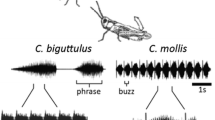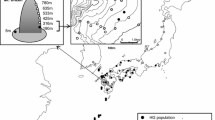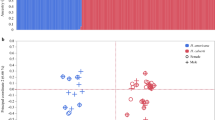Abstract
The mechanical isolation hypothesis predicts that physical incompatibility between divergent reproductive morphologies hinders hybridization between populations. However, evidence for this hypothesis remains scarce. We examined this hypothesis using two parapatric carabid beetles, Carabus insulicola and C. esakii, which are of the subgenus Ohomopterus and exhibit a species-specific genital lock-and-key system. Our interspecific crossing experiment revealed that incompatibility of genital morphologies served as a strong postmating-prezygotic isolation barrier. This isolation was asymmetric: a decrease in female fitness was more costly in the cross with greater genitalic incompatibility between a C. esakii female and a C. insulicola male. These two species share a limited sympatric area, but the mechanism responsible for their coexistence is unclear given no evidence of premating isolation via male mate choice. A comparison of the present results with those of previous studies that quantified reproductive isolation between Ohomopterus species suggest that strong mechanical isolation via genitalic incompatibility plays a major role in species isolation, but that it may be less important in species coexistence.


Similar content being viewed by others
References
Brown WL Jr, Wilson EO (1956) Character displacement. Syst Zool 5:49–64
Butlin RK (1989) Reinforcement of premating isolation. In: Otte D, Endler JA (eds) Speciation and its consequences. Sinaure Associates, Sunderland, pp 158–179
Coyne JA, Orr HA (1989) Patterns of speciation in Drosophila. Evolution 43:362–381
Coyne JA, Orr HA (1998) The evolutionary genetics of speciation. Philos Trans R Soc B-Biol Sci 353:287–305
Coyne JA, Orr HA (2004) Speciation. Sinaure Associates Inc, Sunderland
Eberhard WG (1985) Sexual selection and animal genitalia. Harvard University Press, Cambridge
Gröning J, Hochkirch A (2008) Reproductive interference between animal species. Q Rev Biol 83:257–282
Howard DJ (1993) Reinforcement: origin, dynamics, and fate of an evolutionary hypothesis. In: Harrison RG (ed) Hybrid zones and the evolutionary process. Oxford University Press, New York, pp 46–69
Ishikawa R (1987) On the function of copulatory organs of Ohomopterus (Coleoptera, Carabidae, genus Carabus). Kontyû 55:202–206
Ishikawa R (1991) The evolution of Carabus: divergence and isolating mechanisms. Yasaka-shobo, Tokyo (in Japanese)
Ishikawa R, Ujiie M (2000) A revision of Carabus (Ohomopterus) insulicola Chaudoir, 1869 (Coleoptera, Carabidae) in Honshu, Japan. Jpn J Syst Entomol 6:253–297
Konuma J, Chiba S (2007) Ecological character displacement caused by reproductive interference. J Theor Biol 247:354–364
Kubota K (1988) Natural hybridization between Carabus (Ohomopterus) maiyasanus and C. (O.) iwawakianus (Coleoptera, Carabidae). Kontyû 56:233–240
Kubota K, Sota T (1998) Hybridization and speciation in the carabid beetles of the subgenus Ohomopterus (Coleoptera, Carabidae, genus Carabus). Res Popul Ecol 40:213–222
Kuno E (1992) Competitive exclusion through reproductive interference. Res Popul Ecol 34:275–284
Mikkola K (2008) The lock-and-key mechanisms of the internal genitalia of the Noctuidae (Lepidoptera): how are they selected for? Eur J Entomol 105:13–25
Nagata N, Kubota K, Yahiro K, Sota T (2007) Mechanical barriers to introgressive hybridization revealed by mitochondrial introgression patterns in Ohomopterus ground beetle assemblages. Mol Ecol 16:4822–4836
Okuzaki Y, Takami Y, Sota T (2010) Resource partitioning or reproductive isolation: the ecological role of body size differences among closely related species in sympatry. J Anim Ecol 79:383–392
Panhuis TM, Butlin R, Zuk M, Tregenza T (2001) Sexual selection and speciation. Trends Ecol Evol 16:364–371
Porter AH, Shapiro AM (1990) Lock-and-key hypothesis: lack of mechanical isolation in a butterfly (Lepidoptera: Pieridae) hybrid zone. Ann Entomol Soc Am 83:107–114
Ramsey J, Bradshaw HD Jr, Schemske DW (2003) Components of reproductive isolation between the monkeyflowers Mimulus lewisii and M. cardinalis (Phrymaceae). Evolution 57:1520–1534
Reitz SR, Trumble JT (2002) Competitive displacement among insects and arachnids. Annu Rev Entomol 47:435–465
Ribeiro JMC, Spielman A (1986) The satyr effect: a model predicting parapatry and species extinction. Am Nat 128:513–528
Ritchie MG (2007) Sexual selection and speciation. Annu Rev Ecol Evol Syst 38:79–102
SAS Institute Inc (2009) JMP version 8. SAS Institute Inc, Cary
Servedio MR, Noor MAF (2003) The role of reinforcement in speciation: theory and data. Annu Rev Ecol Evol Syst 34:339–364
Shapiro AM, Porter AH (1989) The lock-and-key hypothesis: evolutionary and biosystematic interpretation of insect genitalia. Annu Rev Entomol 34:231–245
Sota T (2002) Radiation and reticulation: extensive introgressive hybridization in the carabid beetles Ohomopterus inferred from mitochondrial gene genealogy. Popul Ecol 44:145–156
Sota T, Kubota K (1998) Genital lock-and-key as a selective agent against hybridization. Evolution 52:1507–1513
Sota T, Nagata N (2008) Diversification in a fluctuating island setting: rapid radiation of Ohomopterus ground beetles in the Japanese Islands. Philos Trans R Soc B-Biol Sci 363:3377–3390
Sota T, Tanabe T (2010) Multiple speciation events in an arthropod with divergent evolution in sexual morphology. Proc R Soc B 277:689–696
Sota T, Kusumoto F, Kubota K (2000a) Consequences of hybridization between Ohomopterus insulicola and O. arrowianus (Coleoptera, Carabidae) in a segmented river basin: parallel formation of hybrid swarms. Biol J Linnean Soc 71:297–313
Sota T, Takami Y, Kubota K, Ujiie M, Ishikawa R (2000b) Interspecific body size differentiation in species assemblages of the carabid subgenus Ohomopterus in Japan. Popul Ecol 42:279–291
Sota T, Ishikawa R, Ujiie M, Kusumoto F, Vogler AP (2001) Extensive trans-species mitochondrial polymorphisms in the carabid beetles Carabus subgenus Ohomopterus caused by repeated introgressive hybridization. Mol Ecol 10:2833–2847
Takami Y (2002) Mating behavior, insemination and sperm transfer in the ground beetle Carabus insulicola. Zool Sci 19:1067–1073
Takami Y, Suzuki H (2005) Morphological, genetic and behavioural analyses of a hybrid zone between the ground beetles Carabus lewisianus and C. albrechti (Coleoptera, Carabidae): asymmetrical introgression caused by movement of the zone? Biol J Linnean Soc 86:79–94
Takami Y, Nagata N, Sasabe M, Sota T (2007) Asymmetry in reproductive isolation and its effect on directional mitochondrial introgression in the parapatric ground beetles Carabus yamato and C. albrechti. Popul Ecol 49:337–346
Tanabe T, Sota T (2008) Complex copulatory behavior and the proximate effect of genital and body size differences on mechanical reproductive isolation in the millipede genus Parafontaria. Am Nat 171:692–699
Ujiie M, Kubota K, Sota T, Ishikawa R (2005) Parallel formation of hybrid swarms of ground beetles in the genus Carabus (Coleoptera: Carabidae) in adjacent river basins. Entomol Sci 8:429–437
Ujiie M, Ishikawa R, Kubota K (2010) Geographical variation of Carabus (Ohomopterus) esakii Csiki, 1927 (Coleoptera, Carabidae) in Japan. Biogeography 12:53–64
Usami T, Yokoyama J, Kubota K, Kawata M (2006) Genital lock-and-key system and premating isolation by mate preference in carabid beetles (Carabus subgenus Ohomopterus). Biol J Linnean Soc 87:145–154
Yoshimura J, Clark CW (1994) Population dynamics of sexual and resource competition. Theor Popul Biol 45:121–131
Acknowledgments
We are grateful to R. Ishikawa, T. Sota, and M. Ujiie for their cooperation in various ways. Two anonymous reviewers gave many insightful comments and suggestions. This study was partly supported by Grants-in-Aid (11306010, 20248015) to K. Kubota from the Japan Society for the Promotion of Science.
Author information
Authors and Affiliations
Corresponding author
Rights and permissions
About this article
Cite this article
Kubota, K., Miyazaki, K., Ebihara, S. et al. Mechanical reproductive isolation via divergent genital morphology between Carabus insulicola and C. esakii with implications in species coexistence. Popul Ecol 55, 35–42 (2013). https://doi.org/10.1007/s10144-012-0335-4
Received:
Accepted:
Published:
Issue Date:
DOI: https://doi.org/10.1007/s10144-012-0335-4




